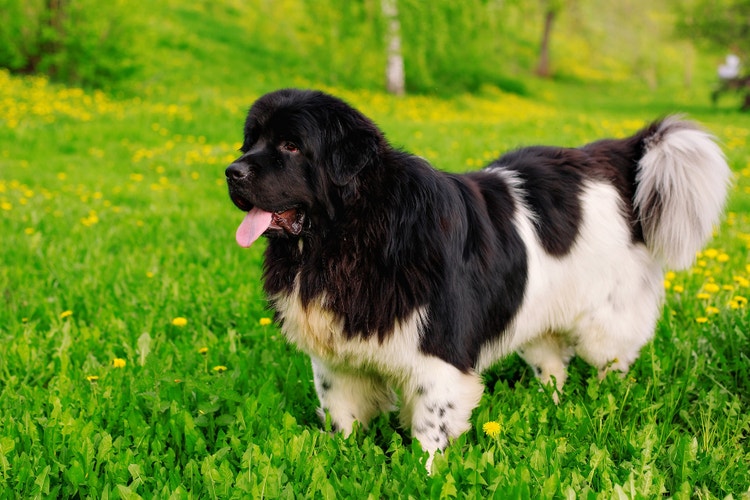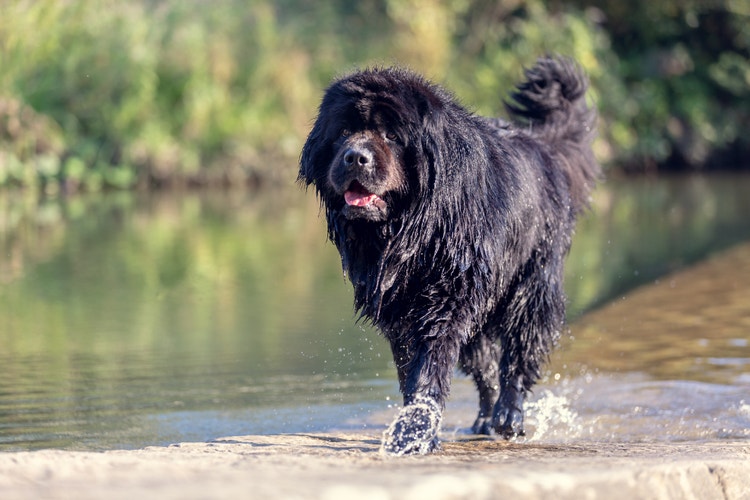
Newfoundland


Where Are Newfoundland Dogs From?
The Newfoundland is a giant-breed working dog that likely evolved centuries ago from breeding between native Indian dogs and Great Pyrenees or Viking dogs. The Newfie was developed to perform water rescues, and to assist fisherman with hauling nets and daily catches to market. Their heavy double coats and webbed feet were perfectly designed for swimming in the icy North Atlantic waters of their homeland.
Today, the Newfie is used extensively for water rescues; their unmatched courage in the water is impressive to behold. Not only suited for water work, they are also ideal babysitters and watchdogs, though they are not aggressive protectors. Their laid back attitudes and loyalty make them wonderful family pets.
Caring for a Newfoundland Dog
What Kind of Diet Does a Newfoundland Dog Need?
What Kind of Diet Does a Newfoundland Dog Need?
During their first year, Newfies need a large amount of calories and specific nutrients to keep up with their rapidly growing bodies. A high-quality, large-breed puppy food should be fed during this time. Once they reach adulthood, their metabolism slows considerably, and they should be given a large-breed formula food. They are prone to gastric dilatation volvulus (GDV or bloat), so it may be helpful to feed smaller, more frequent meals and to avoid exercise around mealtime.
How Much Grooming Does a Newfoundland Dog Need?
How Much Grooming Does a Newfoundland Dog Need?
A Newfoundland requires an owner dedicated to keeping their fur looking its best. Thorough weekly brushing and combing to keep fur mat-and-tangle free is a must. They shed year round, with heavier shedding in spring and fall. Bathing a few times a month will keep the coat shiny and healthy. They also drool quite a bit, and owners are in the habit of carrying a towel to keep mouths clean and dry.
Are Newfoundlands Healthy Dogs?
Are Newfoundlands Healthy Dogs?
Newfies are generally healthy, with an average lifespan of 9 to 10 years. They should be screened for cardiac, orthopedic, and ocular disorders. Owing to their thick double coats, Newfies are very susceptible to heat stroke in warmer months. Gastric dilatation volvulus (bloat) is a very common, life-threatening illness that afflicts this breed. Families should educate themselves to understand and recognize the signs, and know what to do if they are concerned about their dog’s symptoms.
Newfies are predisposed to: gastric dilatation volvulus, heat stroke, hip dysplasia, entropion, ectropion, cataracts, cardiomyopathy, and hypothyroidism.
Less common ailments include patent ductus arteriosis (PDA), atrial septal defect (ASD), and ectopic ureter.

How Much Training Does a Newfoundland Dog Need?
How Much Training Does a Newfoundland Dog Need?
Newfies are generally easy to train. They are intelligent and calm, and do best with gentle training. Puppy classes and early socialization are necessary to ensure a well-behaved adult, especially considering their large size. Newfies were bred to swim, and your puppy should be safely introduced to the water at an early age to acclimate them.

Do Newfoundland Dogs Need A Lot of Exercise?
Do Newfoundland Dogs Need A Lot of Exercise?
Despite their imposing size, Newfies do not require as much exercise as one might think. Daily walks or swimming will usually suffice to keep them happy. More energetic dogs will gladly come along for a family hike or participate in search and rescue, agility, dock diving, and cart pulling.
What Are the Physical Characteristics of a Newfoundland Dog?
Newfoundland Facts
Other Breeds to Explore
References
- Newfoundland Dog Breed Information and Personality Traits. Hill’s Pet Nutrition, Inc., 2020.
- American Kennel Club. The Complete Dog Book. Random House Digital, Inc., 2006.
- Morris, Desmond. Dogs: The Ultimate Dictionary of Over 1,000 Dog Breeds. Trafalgar Square, 2002.
- Wilcox, Bonnie and Chris Walkowicz. The Atlas of Dog Breeds of the World. T.F.H Publications, Inc., 1995.


